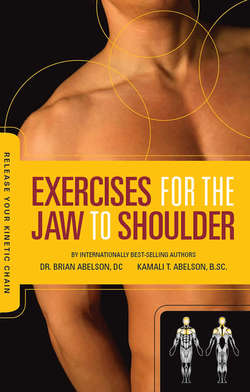Читать книгу Exercises for the Jaw to Shoulder - Release Your Kinetic Chain - Dr. Brian James Abelson DC. - Страница 27
На сайте Литреса книга снята с продажи.
Neurological Impact of the Neck’s Kinetic Chain
ОглавлениеIn addition to the immediate kinetic chain connections that we can see with adjacent soft tissue structures, we must also consider how the nervous system in the affected area of the kinetic chain directly impacts the function of the entire body.
Whenever an injury occurs in your neck (such as a sprain/strain), it damages not only the ligaments, tendons, and muscle fibres, but also their embedded neurological structures (Golgi tendon organs, muscle spindles, and joint receptors). These neurological structures play an essential role in postural control. Any damage to these structures can affect overall spinal stability, and lead to chronic back problems.
In order to get a better understanding of the importance of these neck muscles and their role in controlling body posture and gait, let us consider the suboccipital muscles (located at the base of your skull).
The suboccipital muscles (rectus capitis major and minor, superior and inferior obliques) are extremely important since they contain very high concentrations of muscle spindle fibres. Muscle spindles are the part of your nervous system that provide postural information to the central nervous system. Damage to these structures can result in gait disturbances and ataxia (an inability to coordinate voluntary muscle movements).
When we compare the density of muscle spindles that pass through or occupy the suboccipital area, to that of other muscles in the spine, it becomes obvious just how much this area affects whole body function.
Take a minute to review the density of muscle spindles per gram of muscle tissue:2
Table 1: Density of Muscle Spindles per gram of muscle tissue
The higher the density of muscle spindles/gm of muscle tissue, the greater the involvement of this area in maintaining whole-body postural control.
Given this, you can see that the inferior oblique muscle (located at the base of your skull) contains 242 spindles/gm of muscle tissue, while the very large latissimus dorsi (large back muscle) only contains 1.4 spindles/gm of muscle tissue.
Even though the inferior oblique is located at the base of your skull, due to the density of muscle spindles in this area, a restriction in this muscle can affect far distant structures; from your neck through to your lower back.
The key point is that any exercise program or treatment protocol must address and resolve issues within all the structures making up your neck’s kinetic chain. This is required in order to deal with the consequences of restrictions which impact the neck’s physical kinetic chain and cascade into your neurological control mechanisms.
This is why you need to perform all the exercises recommended within each routine, even when you cannot see its connection to your particular problem. We have found this method to be the most successful approach for treating our patients.
